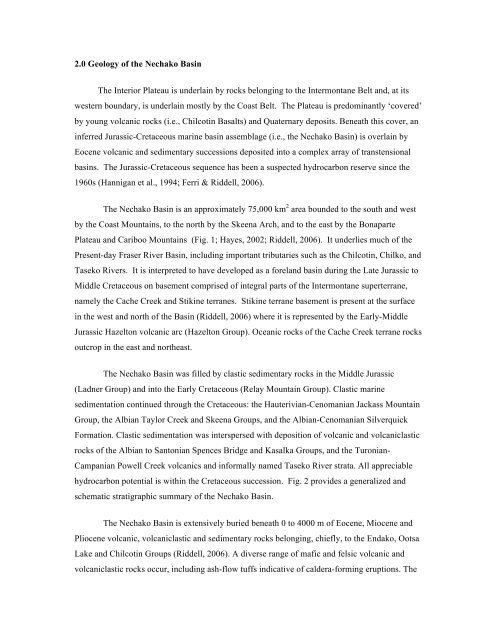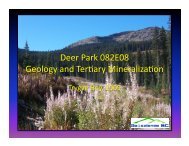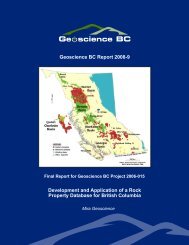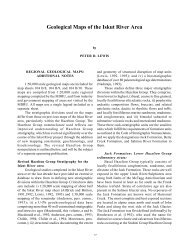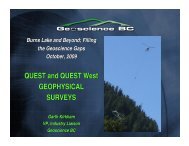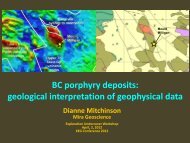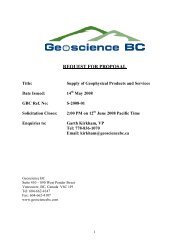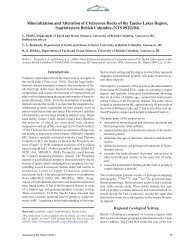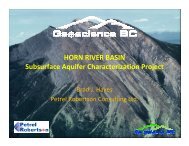Report - Geoscience BC
Report - Geoscience BC
Report - Geoscience BC
You also want an ePaper? Increase the reach of your titles
YUMPU automatically turns print PDFs into web optimized ePapers that Google loves.
2.0 Geology of the Nechako Basin<br />
The Interior Plateau is underlain by rocks belonging to the Intermontane Belt and, at its<br />
western boundary, is underlain mostly by the Coast Belt. The Plateau is predominantly ‘covered’<br />
by young volcanic rocks (i.e., Chilcotin Basalts) and Quaternary deposits. Beneath this cover, an<br />
inferred Jurassic-Cretaceous marine basin assemblage (i.e., the Nechako Basin) is overlain by<br />
Eocene volcanic and sedimentary successions deposited into a complex array of transtensional<br />
basins. The Jurassic-Cretaceous sequence has been a suspected hydrocarbon reserve since the<br />
1960s (Hannigan et al., 1994; Ferri & Riddell, 2006).<br />
The Nechako Basin is an approximately 75,000 km 2 area bounded to the south and west<br />
by the Coast Mountains, to the north by the Skeena Arch, and to the east by the Bonaparte<br />
Plateau and Cariboo Mountains (Fig. 1; Hayes, 2002; Riddell, 2006). It underlies much of the<br />
Present-day Fraser River Basin, including important tributaries such as the Chilcotin, Chilko, and<br />
Taseko Rivers. It is interpreted to have developed as a foreland basin during the Late Jurassic to<br />
Middle Cretaceous on basement comprised of integral parts of the Intermontane superterrane,<br />
namely the Cache Creek and Stikine terranes. Stikine terrane basement is present at the surface<br />
in the west and north of the Basin (Riddell, 2006) where it is represented by the Early-Middle<br />
Jurassic Hazelton volcanic arc (Hazelton Group). Oceanic rocks of the Cache Creek terrane rocks<br />
outcrop in the east and northeast.<br />
The Nechako Basin was filled by clastic sedimentary rocks in the Middle Jurassic<br />
(Ladner Group) and into the Early Cretaceous (Relay Mountain Group). Clastic marine<br />
sedimentation continued through the Cretaceous: the Hauterivian-Cenomanian Jackass Mountain<br />
Group, the Albian Taylor Creek and Skeena Groups, and the Albian-Cenomanian Silverquick<br />
Formation. Clastic sedimentation was interspersed with deposition of volcanic and volcaniclastic<br />
rocks of the Albian to Santonian Spences Bridge and Kasalka Groups, and the Turonian-<br />
Campanian Powell Creek volcanics and informally named Taseko River strata. All appreciable<br />
hydrocarbon potential is within the Cretaceous succession. Fig. 2 provides a generalized and<br />
schematic stratigraphic summary of the Nechako Basin.<br />
The Nechako Basin is extensively buried beneath 0 to 4000 m of Eocene, Miocene and<br />
Pliocene volcanic, volcaniclastic and sedimentary rocks belonging, chiefly, to the Endako, Ootsa<br />
Lake and Chilcotin Groups (Riddell, 2006). A diverse range of mafic and felsic volcanic and<br />
volcaniclastic rocks occur, including ash-flow tuffs indicative of caldera-forming eruptions. The


